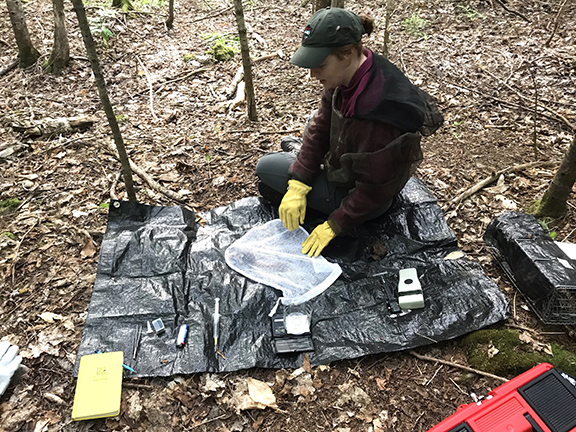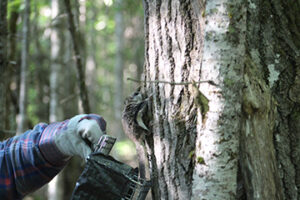
The Response of the Northern Flying Squirrel (Glaucomys Sabrinus) to Rising Ambient Temperatures, Aroostook State Park, Presque Isle, Maine
Expedition Dates: May 31 – August 11, 2019
Field Team Members:
Elise K. Gudde1,2, Danielle L. Levesque1,2, Stephanie Ross3
1 School of Biology and Ecology, University of Maine, USA
2 Climate Change Institute, University of Maine, USA
3 Department of Wildlife, Fisheries and Conservation Biology, University of Maine, USA
Expedition Funding: UMS Research Reinvestment Fund Grant

The relationship between animals and their thermal environment has been gaining attention in the fields of ecology and physiology, and while other studies have focused on warming winter climates, we examine the rising summer temperatures as a driver of observed range shifts. We focused on the northern flying squirrel (Glaucomys sabrinus) to determine the effect of high temperatures on thermoregulation and energy use. The primary goal of this expedition was to expand our knowledge of thermoregulation in Northern flying squirrels by examining the effects of high ambient temperatures on metabolic rate and body temperature, and to better understand the relationships between mammalian activity patterns and vulnerability to climate change.
Data collection:
In the summer of 2019, our expedition team travelled to Aroostook State Park, Presque Isle, Maine, USA to begin our field work. In the State Park, Northern flying squirrels were captured using Tomahawk traps baited with peanut butter and granola. Traps were placed on the forest floor in a grid pattern, and were opened at dusk and closed at sunrise. Once captured, flying squirrels were transferred from the trap into a handling bag where they were identified to species, and general measurements were taken. Squirrels were tagged with a small mammal ear tag, and a temperature sensitive PIT tag was injected into the squirrel. Flying squirrels were then brought to the lab for further data collection.

Figure 2: Forest where traps were set in Aroostook State Park, Presque Isle, ME.

Flying squirrels were brought back to the lab at the University of Maine at Presque Isle, ME, USA and temperature sensitive data loggers (used to collect core body temperature) were implanted into the squirrels through surgical procedure. Radio collars were attached onto the squirrel to allow for radio telemetry when released back to the forest. Radio telemetry was used to monitor activity patterns and for squirrel recapture. We measured resting metabolic rate and subcutaneous body temperature of northern flying squirrels across a range of ambient temperatures using flow-through respirometry.

The results from this expedition will help us to use a predictive climate mode to determine the effects of high ambient temperatures on Northern flying squirrels. Our findings from this research expedition will also help us to have a better understanding of the relationship between activity patterns and an animal’s vulnerability to climate change.

